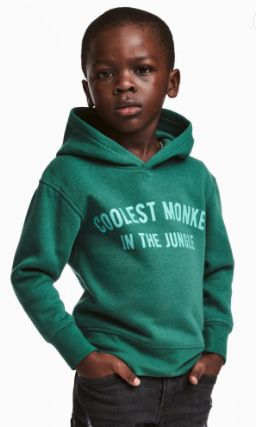
So… we’re eleven days into the New Year but already 2018 has kicked off with a whole new host of entertainment scandals (*cough* Logan Paul *cough*) and more relevant to this article, PR disasters: that’s right H&M, we’re looking at you. The clothing retailers have recently come under fire for an image on their website, in which they use a black model to advertise a hoodie in their children’s line which boasts the slogan “ Coolest Monkey in The Jungle”. Earlier this week the brand were called out for their use of the black model to promote this particular piece of clothing; which many have pointed out is reminiscent of those of African descent being referred to as “monkeys” as a way of demeaning them and propagating a culture which places black people as lesser than their white counterparts. H&M swiftly released a statement apologising for the image, removing it from their website and social channels as well as pulling the hoodie itself from shelves – but the damage was already done. Numerous big names such as Abel Tesfaye, also known as The Weeknd, have withdrawn their support from the company and some are even calling for a total boycott of the brand. I certainly wouldn’t want to be working in the H&M PR department right now.
Yet, whilst there are big names up in arms against H&M this week, Twitter users are divided on the subject; with some declaring that those viewing the photo as racist are the ones associating the black child with the monkey imagery, not the actual use of the model by H&M themselves. I think this is an extremely difficult situation to explain or even have an opinion on – but I’m going to give it a go regardless:
I, as a privileged white student, don’t get to decide what someone of another race finds offensive – especially since the race in question has been beaten down and treated as something less than human by my own race throughout history – I don’t get to do that. The monkey imagery and all other kinds of derogatory references like it continue to be a problem in our contemporary society, harking back to the days when we at large saw nothing wrong with owning people and exchanging them as property, commodities of the colonial endeavour. But – and this is a big but – in my own personal opinion I do not believe that H&M meant anything malicious in their production and use of the image. We, at least in the UK, refer to children as cheeky monkeys on an everyday basis, the mistake to me seems an honest one; and their swift apology genuinely heartfelt. They realised that what they had done had been interpreted badly and took quick action to acknowledge people’s concerns and remove not only the offending image but the product itself. I’m not totally sure they deserve the full weight of the backlash which has fallen on them.
I think what has happened is that H&M have simply just not seen race as they produced the image: they took a cute little boy and used him to advertise this hoodie, as all children are little rascals and monkeys in their own way; they haven’t seen the possible connotations of that particular hoodie on that particular child. And now you may be confused, because isn’t this what we all want? We want to live in a society where we do not see people as one race or another; we want to be colour-blind, so to speak. Just like we want to live in a world where it isn’t a big deal to have a female U.S President or Doctor Who – we want to get to a point in society where none of these things influence anything anymore.
And so, in that way you may think that there is nothing wrong with the image, and that it is actually more racially prejudiced to take the image down, because it was never intended as a racial slur. But we must also remember that, unfortunately, we do not yet live in that perfectly unprejudiced world; and in the world that we do live in it is still black people who are 3 times more likely to be killed by the police in the U.S, whilst only 1% of the white officers who kill them are held accountable and convicted. Until such a time that statistics like this are not the case, we must continue to try harder and do better; and the image from H&M falls into this category too. We must continue to challenge such things that could be interpreted in these prejudiced ways even if it was unintended, as then, and only then, can we continue to edge closer to that perfectly unprejudiced world.
I have no doubt that H&M will make it through this scandal – a little bruised and battered but nevertheless intact – but the conversation will continue, as it must do, for the good of everyone.
